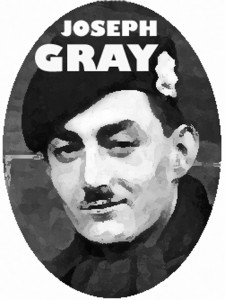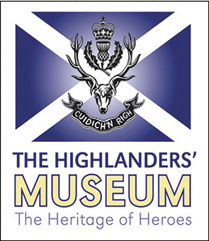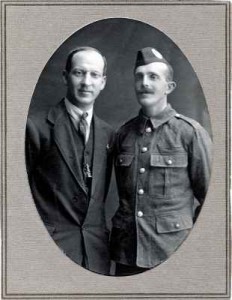
ANDREW PATERSON was the founder of the Camerons’ Comforts Fund during the First World War. It was on his initiative that the fund was set up, and he personally undertook the task of packing parcels, night after night until the early hours of the morning, for the men serving in the different Battalions of The Queen’s Own Cameron Highlanders.
The Highland Times of 22nd June 1916 reported: “Tonight (Wednesday) the proposal of Mr Steele, of the Theatre Royal, to hold a free gift sale in aid of the fund for comforts for the Cameron Highlanders is to be carried into effect…Appeal is made for more such gifts, which should be sent to the studio of the Hon. Secretary, Mr Andrew Paterson, photographer, Academy Street.”
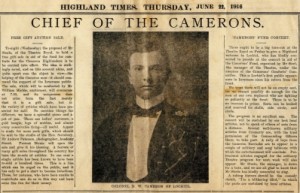
Paterson also organised the Camerons’ Fair, a remarkable effort which, with only six weeks’ preparation, raised over £4,000 for the Fund. In 1917 the Highland News of 13th January printed letters of appreciation from the western front addressed to Paterson as Fund Secretary. Lt.Col. R.L.McCall wrote: “We have just received your consignment of socks, hose tops, scarfs, and shirts, for which please accept the thanks of the Battalion. These gifts are much appreciated by the men, and are of extraordinary use, especially now the cold weather is starting. I am afraid letters convey a small amount of what we wish to express, but I hope you will understand how much we appreciate the thoughts for our welfare of those at home.”
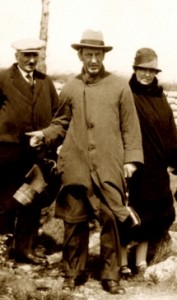
First World War.
A further shipment of comforts was despatched soon afterwards, including 3,200 pairs of socks, 1,350 mufflers, 240 shirts and 325 pairs of hose tops.
In April 1917, Paterson’s brother-in-law, George Alexander MacLennan was killed on the western front in Arras. A Lance-Corporal in the 7th Queen’s Own Cameron Highlanders (1st Battalion), he left a widow and three children. (He is interred at the British Tank Cemetery in Guemappe.) MacLennan’s newspaper obituary featured a portrait by Paterson.
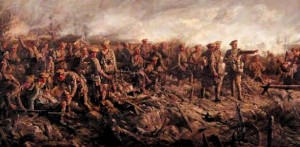
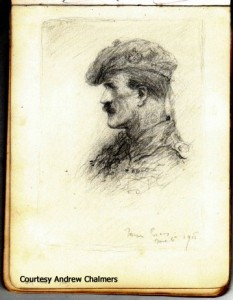
more than just his name when Constance Paterson presented her autograph book.
In 1918, Paterson commissioned his friend, the well-known artist Joseph Gray (1890-1963), who had fought with the 4th/5th Black Watch during the war, to paint two war pictures, one of the 4th Seaforths and the other of the 6th Camerons at the Battle of Loos; in 1946 he gave the latter painting on permanent loan to the Cameron Highlanders for the Depot at Inverness. Both paintings can now be seen on display at The Highlanders’ Museum in Fort George.
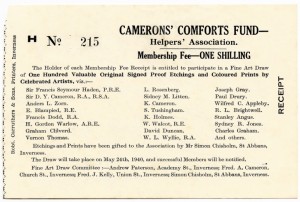
which took place in May 1940.
Paterson re-established the Camerons’ Comforts Fund at the start of the Second World War. The Inverness Courier in October 1939 reported: “A meeting in connection with the Camerons’ Comforts Fund was held on Monday in the Caledonian Hotel, Inverness, by kind permission of Mr Airth (manager). Lady Hermione Cameron of Lochiel was in the chair. The meeting was a very representative one, and had been called with the object of discussing the amalgamation of two committees, one which had done yeoman service during the Great War, 1914-1918 by collecting and sending out comforts of all kinds to units connected with Inverness, represented by Dr Barron, Mr A. Paterson [and others]…the other, consisting of…officers and their wives, all closely connected with the Cameron Highlanders…”
Paterson became a member of the committee, and the news article ended with a list of donations already received (including £2 from Paterson himself). One raffle initiated to raise funds was the Fine Art Draw, which took place in May 1940. On offer were 100 original signed proof etchings and coloured prints by celebrated artists (including Joseph Gray).
There is some evidence Paterson was involved in sending comforts to soldiers serving overseas much earlier than 1914-1918. In 1900 Paterson received in the post a copy of a Dutch Bible, damaged by the track of a bullet hole. In an accompanying letter from Lance Corporal G. Caulfield of the 1st Gordon Highlanders serving in South Africa, Paterson is thanked for sending items to the troops.
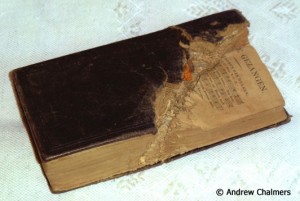
a grateful Lance Corporal Caulfield in
South Africa sent to Paterson to
add to his collection.
Caulfield wrote: “Just a few lines when I have the opportunity of letting you know that I received your present of tobacco & pipes all safe and I must tell you I was highly pleased with it. You will have to excuse me for not writing a thank you sooner but as we have been knocking about all over South Africa I have had very little time for writing, and I was also waiting for our kits to come up as I had a Dutch Book I was going to send you for a small momento [sic] from here.”
Caulfield continued: “Well the kits having arrived yesterday I am sending you on the book by this mail and I hope it will suit your collection. It was taken out of Cronje’s Laager after his surrender. [Cronje was a general of the South African Republic’s army during the Boer wars of 1880-1881 and 1899-1902. Cronje’s Laager refers to the Battle of Paardeberg where he surrendered with 4,150 of his commandos in 1900.] I found it on one of his men who had been killed by one of our bullets after having been saved once by his Bible as you will be able to see for yourself.”
After a description of skirmishes with the Boers, Caulfield concluded: “I will have to draw to a close by again thanking you for the presents.” Caulfield had previously served in India and was awarded the India Medal with the Relief of Chitral clasp in 1895.
For more on Joseph Gray visit our sister site
To see the original Joseph Gray paintings visit The Highlanders’ Museum in Fort George
